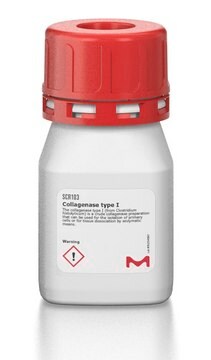B20222
Collagenase - Hyaluronidase blend
Tissue dissociation blend, lyophilized powder, suitable for cell culture
About This Item
Recommended Products
Quality Level
form
lyophilized powder
specific activity
(Collagenase activity : 1-5 units/ml in 10 ml HBSS (#H6648; FALGPA assay))
(Hyaluronidase activity : 80-400 units/ml in 10 ml HBSS (#H6648; Hyaluronidase assay))
concentration
1 mg/mL (Collagenase)
technique(s)
cell culture | mammalian: suitable
shipped in
dry ice
storage temp.
-10 to -25°C
Related Categories
General description
Biochem/physiol Actions
Preparation Note
Signal Word
Danger
Hazard Statements
Precautionary Statements
Hazard Classifications
Resp. Sens. 1
Storage Class Code
13 - Non Combustible Solids
WGK
WGK 2
Flash Point(F)
Not applicable
Flash Point(C)
Not applicable
Choose from one of the most recent versions:
Certificates of Analysis (COA)
Sorry, we don't have COAs for this product available online at this time.
If you need assistance, please contact Customer Support.
Already Own This Product?
Find documentation for the products that you have recently purchased in the Document Library.
Our team of scientists has experience in all areas of research including Life Science, Material Science, Chemical Synthesis, Chromatography, Analytical and many others.
Contact Technical Service








